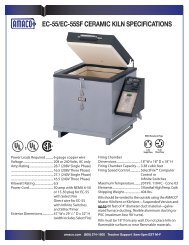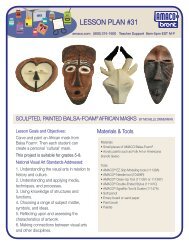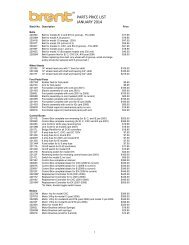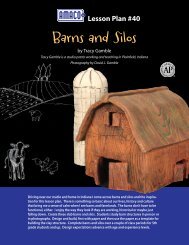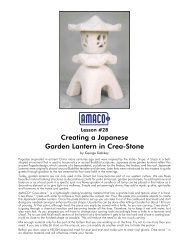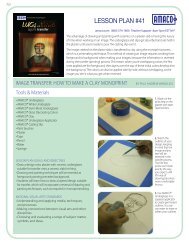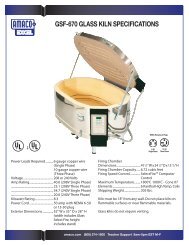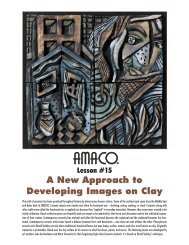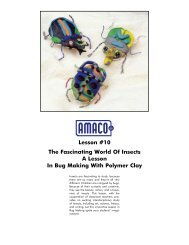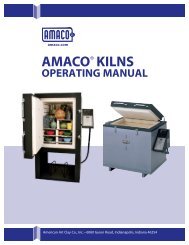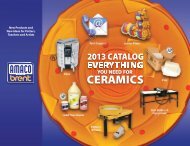Lesson #14 Recreating Chinese Bronze Vessels - Amaco
Lesson #14 Recreating Chinese Bronze Vessels - Amaco
Lesson #14 Recreating Chinese Bronze Vessels - Amaco
You also want an ePaper? Increase the reach of your titles
YUMPU automatically turns print PDFs into web optimized ePapers that Google loves.
Above, From Left: Jessica Manriquez, grade 11; Jacques Law, grade 10; Tara Scott, grade 10.<br />
<strong>Lesson</strong> <strong>#14</strong><br />
<strong>Recreating</strong> <strong>Chinese</strong><br />
<strong>Bronze</strong> <strong>Vessels</strong><br />
The <strong>Chinese</strong> <strong>Bronze</strong> Age last ed from the 16th Cen tu ry B.C. to<br />
ap prox i mate ly the be gin ning of the modern era. During this brilliant<br />
chapter in Chi nese history, the Chi nese of the Shang and<br />
Early Chou Dynasties used bronze ves sels as part of the burial<br />
process and ancestor wor ship. They be lieved that their de ceased<br />
rel a tives did not suffer death as we know it, but went to another,<br />
very similar world where they lived forever. The deceased need ed<br />
food, cloth ing, and household utensils, and so these things were<br />
bur ied with them. <strong>Bronze</strong> vessels were used to hold food and wine<br />
as an integral part of the funeral ceremony, because these vessels<br />
would last for ev er. In this lesson, high school students learn the<br />
art of recreating Chi nese <strong>Bronze</strong> <strong>Vessels</strong> using clay, spe cial ized<br />
glazes, and Rub ‘n Buff ® .
3. Explain that the students<br />
are making a vessel that is<br />
de signed to hold something<br />
of value. The vessels in this<br />
les son are based loosely on<br />
the <strong>Chinese</strong> ting ves sels of<br />
the Shang Dynasty. The vessels<br />
were used in various cer<br />
2<br />
e mo nies, especially funerals.<br />
The designs were based on<br />
an i mal and geometric forms.<br />
Some de signs show a symmetrical<br />
hu man mask. Late Shang<br />
de sign ers used zoomorphic<br />
mo tifs with quad ru peds,<br />
rep tiles, birds, and insects.<br />
4. Explain that the students will<br />
be making “faux” <strong>Chinese</strong><br />
<strong>Bronze</strong> <strong>Vessels</strong> and what techniques<br />
and materials were<br />
used to create the originals.<br />
5. Describe the techniques and<br />
materials used in this lesson<br />
plan—coil and slab building,<br />
carving, and finishing techniques.<br />
Show students ex amples<br />
of pieces created us ing<br />
these methods.<br />
Glossary:<br />
<strong>Lesson</strong> Goals and<br />
Objectives:<br />
1. Students learn to make<br />
Chi nese <strong>Bronze</strong> <strong>Vessels</strong> using<br />
coil or slab-built clay ceramic<br />
tech niques.<br />
2. The lesson incorporates art<br />
history, aesthetics, and crit i<br />
cism with a hands-on activity.<br />
3. The lesson focuses on various<br />
ceramic techniques and<br />
im por tant composition and<br />
de sign el e ments essential to<br />
cre at ing a carved ceramic<br />
box in the style of the<br />
<strong>Chinese</strong> <strong>Bronze</strong> <strong>Vessels</strong>; fundamental<br />
tech ni cal skills for<br />
using specialty glazes and<br />
fin ish ing products to create<br />
unique surfaces; and selfexpression.<br />
Co u r t n e y Lo w e, Gr a d e 10.<br />
Background and<br />
Prep a ra tion:<br />
1. This lesson is designed for high<br />
school students, but can be<br />
used with mod i fi ca tion for middle<br />
school students, as well.<br />
2. An overview of the his to ry of<br />
<strong>Chinese</strong> <strong>Bronze</strong> Ves sels should<br />
be presented with var i ous<br />
ex am ples shown to the<br />
stu dent. In ad di tion to show ing<br />
stu dents pho to graphs, plan a<br />
trip to the local art museum to<br />
see ac tu al ex am ples of these<br />
ves sels.<br />
Bisque—Unglazed pottery af ter<br />
first firing.<br />
<strong>Bronze</strong>—An alloy of copper and<br />
tin and sometimes other el e ments<br />
that is very hard and strong; often<br />
used for cast sculp tures.<br />
Composition—The organization<br />
of a work of art.<br />
Dynasty—A succession of rul ers<br />
of the same line (family).<br />
Kristine Hashimoto, Grade 10.
Fire—A term used in ceramics;<br />
to heat the clay in a kiln at a very<br />
high temperature until it is dry<br />
and hard and becomes pottery.<br />
Glaze—A special clear or colored<br />
liquid mixture that is ap plied<br />
to pottery and becomes a hard<br />
glass surface when fired to the<br />
right temperature in a kiln.<br />
Quadruped—animal on four<br />
legs.<br />
Score—To scratch or “rough<br />
up” surfaces of clay that are to<br />
be joined together.<br />
Scoring—A method of joining<br />
two parts of clay together that<br />
have dried to a leather-hard<br />
stage by scratching the two surfac<br />
es and spreading slip be tween<br />
them as a “glue.”<br />
Slip—Clay that has been wa tered<br />
down to a creamy con sis ten cy.<br />
Template—A positive pattern.<br />
Ting—A shape or style of an cient<br />
<strong>Chinese</strong> <strong>Bronze</strong> <strong>Vessels</strong>.<br />
Underglaze—A special type of<br />
color that is put on a ceramic<br />
piece before the glaze. It has no<br />
flux (glass former) in it so it stays<br />
where it is put when fired and is<br />
good for detail work. It is used<br />
for painting and decorating.<br />
Vessel—Container.<br />
Zoomorphic—Animal-like;<br />
some thing that is not an an i mal,<br />
but is made to look like one or<br />
given animal-like char ac ter is tics.<br />
Supplies:<br />
Clay<br />
AMACO ® Alligator Glazes<br />
AMACO ® Rub ‘n Buff ®<br />
AMACO ® Clay Shapers<br />
Carving Tools<br />
Wooden Paddle<br />
Additional Supplies:<br />
Paper<br />
Pencils<br />
Newspaper<br />
Plastic for Wrapping Clay<br />
Vinegar<br />
Slab Roller or Rolling Pin<br />
Kiln<br />
<strong>Chinese</strong> (Unknown). Ritual Vessel (fangding),<br />
11th century B.C. <strong>Bronze</strong>; 9 1 /2" high with<br />
handles. Indianapolis, Museum of Art,<br />
Gift of Mr. and Mrs. Eli Lilly. Photograph<br />
©1990, Indianapolis, Museum of Art.<br />
Instructions:<br />
1. After looking at pictures of<br />
vessels and discussing the histo<br />
ry, students should draw the<br />
shape and design of the vessel<br />
they want to create. <strong>Vessels</strong><br />
should be approximately 10"<br />
in height. The teacher should<br />
ap prove design to be sure it is<br />
fea si ble.<br />
2. Make patterns from news paper<br />
for vessel. The teach er<br />
should again check the size<br />
on the patterns to be sure<br />
they are the proper size to<br />
work for this project.<br />
3<br />
<strong>Chinese</strong> (Unknown). Ritual Vessel (liding),<br />
11th century B.C. <strong>Bronze</strong>; 9” high.<br />
Indianapolis, Museum of Art, Gift of Mr.<br />
and Mrs. Eli Lilly. Photograph ©1990,<br />
Indianapolis, Museum of Art.<br />
3. If slab building, roll slab to<br />
approximately 3 /8-inches thick.<br />
Using template or pat tern, students<br />
now cut the bottom and<br />
sides of the ves sel. Have them<br />
layer slabs between ap proxi<br />
mate ly 20 sheets of newspaper<br />
and then wrap slabs<br />
and paper in plastic overnight.<br />
The news pa per pulls<br />
enough moisture out of the<br />
clay so that it is firm enough to<br />
build the form. Put the piec es<br />
together by scor ing the edges<br />
and using slip and/or vinegar<br />
plus a coil on the inside to<br />
seal the edges. Be sure the<br />
sealed edge is smoothed with<br />
a damp sponge.<br />
4. If coil building, students should<br />
first cut the shape of the base.<br />
Use a small rib to smooth<br />
the coils as they go. Use a<br />
card board template cut to the<br />
shape of the ves sel to get the<br />
correct shape. If the vessel<br />
seems too soft, stuff newspaper<br />
inside to dry it out.<br />
5. Have students make legs<br />
and/or tops for their con tainers<br />
us ing either the slab or<br />
coil tech nique. Use the slip<br />
and/or vin e gar tech nique to<br />
at tach the legs or handles.<br />
6. When not working on the<br />
vessels, students should keep<br />
them loosely covered in plastic<br />
so that they do not dry out<br />
and become hard.
7. When the students have<br />
com plet ed building their vessels,<br />
they should draw the<br />
de sign they want to carve on<br />
a piece of paper and have it<br />
approved by the teacher.<br />
8. Provide students with ex amples<br />
of Japanese border<br />
de signs and other design<br />
motifs. Encourage them to<br />
create com plex, intricate,<br />
interesting de signs and to<br />
stay away form the usual<br />
hearts, stars, rainbow, and<br />
sun designs.<br />
9. The design should then be<br />
transferred to the sides of the<br />
vessel.<br />
10. Carving is done with a va riety<br />
of ceramic carving tools.<br />
Urge students to carve their<br />
de signs carefully to dif ferent<br />
depths without cutting<br />
through the clay.<br />
11. When the design is complete,<br />
allow pieces to dry slowly to<br />
avoid cracking.<br />
12. When thoroughly dry, bisque<br />
fire to cone 03.<br />
13. Textured Alligator Glazes<br />
com bined with Rub ‘n Buff ®<br />
create the “faux” an cient<br />
bronze finish. Apply three<br />
coats of glaze to the bisqued<br />
vessel. Fire to cone 04.<br />
14. When the piece is fired and<br />
cooled, apply Rub ‘n Buff ® to<br />
Crystal Morris, Grade 10.<br />
the vessel with a soft cloth and<br />
gently buff to a metallic luster.<br />
15. The vessels can be dec o<br />
rat ed with a variety of finishes:<br />
un der glaz es plus Rub<br />
‘n Buff ® , acryl ic paint plus<br />
Rub ‘n Buff ® or un glazed<br />
raku fired.<br />
Examples of <strong>Chinese</strong> <strong>Bronze</strong> Ves sels are by students at Oakmont High School, Colfax, California.<br />
This lesson was originally de vel oped by Barrie Burnham, Art Teach er.<br />
This is one lesson in a series of art plans for elementary and sec ond ary programs using Amer i can Art Clay Co., Inc. products.<br />
American Art Clay Co., Inc. • 6060 Guion Road • Indianapolis, Indiana 46254 • (317)244-6871 • (800)374-1600<br />
4<br />
11898W 25M0499



